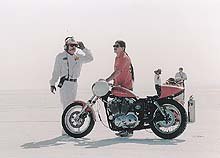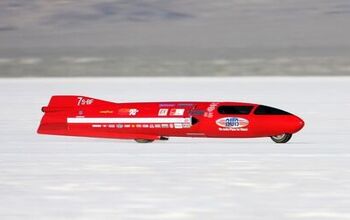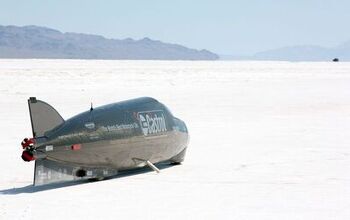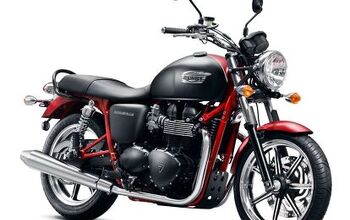Bonneville Speed Fever
"As the speed builds, I crouch down in such a tight tucked position that my helmet jitters as it hits the top of the tank."
"Krazy" Keith Kardell is world famous for his motorcycle stunt riding antics, including a 12.5 second quarter mile time while riding backwards on his Harley-Davidson Sportster. The following report is Keith's accounting of his world-record-setting run at the Bonneville Salt Flats this past summer in the MPG 1650 class (Modified frame, Push rod, Gas engine) aboard a 1987 Bartels' Harley-Davidson Sportster. Keith and his mechanic, Dave Rivera, have been racing this bike for the past three years at SCTA land speed events on a 1-1/3 mile course at El Mirage dry lake bed in the California desert.
We arrived at Bonneville, Utah, on Saturday August 17th with our Sportster in the trailer.
Soon after arrival, we learned that we could actually make a pass that day (we had originally thought that Saturday was for tech only). The course was holding up great. The SCTA had six different lanes marked out on the salt and even by Tuesday, they still hadn't moved the course from the first lane. These six lanes were for the "short course," three miles from the starting line to the final timing lights. There is also a seven mile "long course" for vehicles going over 200 mph.
I listen closely to the sound of the engine so I can react quickly by pulling the clutch if I hear any sounds indicating the engine is coming apart. When I finally come to a stop on the return road, I'm stunned at just how quiet it is. I take off my helmet and gloves to wait for the crew to come pick me up and I try to guess at how fast I've gone.As I pass the one mile marker, I'm studying the course surface and concentrating on avoiding debris. At 150 mph, you can get tunnel vision and cannot focus on anything on the side of the course. When I pass the three mile marker, I let off the gas and pull in the clutch. Being careful not to sit up just yet, I reach with my right hand over to the left side of the handle bars and pull the wrist strap kill switch so that later we can get a plug reading. The starter official at the starting line loves to tell stories about riders who have been blown off of their motorcycles because they sat up too soon after passing the last mile marker.
Bonneville salt is very white and the racing lines are made with oil. The salt on the course and on all the roads and in the pits is graded and packed, but when I pull off the course, I'm driving on virgin salt, and it clings to the under side of the bike and packs between the tires and the fenders.
Soon my crew shows up and they've heard the results over the CB radio. Is it a record?
The results:
9:09am with gearing 43/23, entry speed of 140.539 and terminal speed of [email protected] 5937 rpm
1:15pm with gearing 41/23, entry speed of 146.457 and terminal speed of [email protected] 5884 rpm
The bike was still cutting out on both of Sunday's passes, so that night at the KOA campgrounds we worked on the bike in the trailer. Dave removed the float bowl and he found some crud in the main jet which we felt could be causing the problem. It may have been caused by old racing fuel which was in our tank since the last time we had the bike out. As we worked in the trailer that night, a rain storm passed through and blew down several tents in the camp grounds. Was the following day's event going to be rained out?
We needn't have worried. On Monday morning, the sun was shining brightly as I lined up for my first pass at 9:00 am, but man, it was cold. This time, the bike did not miss a beat through each of the gears. But when I shifted into fourth gear, the throttle cable broke. We could not find a replacement cable from any of our friends so we had to cut off the bad part of the cable and reattach it to the carburetor. There was just enough length left and when the handle bars were turned all the way to the left, the cable was stretched to the max. This didn't bother me much because I was always killing the engine long before turning to the left to exit the course where we did spark plug readings.
On Monday morning, the sun was shining brightly as I lined up for my first pass at 9:00 am, but man, it was cold. This time, the bike did not miss a beat through each of the gears.
The bike had to be left in the impound area over night so we detached the trailer and left the bike in it. At past events, record runs had to be backed up with a pass in the opposite direction within the next hour, and then the two speeds were averaged in case there was a wind blowing in any one direction. But, at this event, they had us make our backup pass first thing the next morning, which suited us fine. Early in the morning the air is cool and dense, and the motor runs best then.
The next morning (Tuesday) turned out warmer than we expected. I was the first vehicle down the course that morning and the bike once again ran great. But because the temperature was higher, our backup run was slower than our run the day before, although still high enough to get into the SCTA/BNI record book with 148.894 mph average.
With the backup run complete, it was time to head off to the tech area for a fuel check, and to validate the engine displacement. A hose was attached to the spark plug hole and the other end was attached to a long, calibrated glass tube. Automatic transmission fluid was pored into the tube and it flowed down in the combustion chamber. Then, with the bike in gear, I turned the rear wheel. As the piston went up and down, the inspector noted the top and bottom points on the calibrated glass tube. He computed the difference and multiplied it by two (two cylinders) to get the total engine displacement. He came up with 1502cc. The class limit is 1650cc (102ci). We were legal! Now we've just got to wait for our trophy, which will be handed out at the SCTA banquet in California in January. There is no prize money in this sport, but the trophies for record setting runs are very prestigious.
But as I go down the course, it sure makes my heart beat fast -- like a fever.
Funny thing about the salt, though -- I found I got that fever bad after my first time there!
Two more Bonneville meets will occur in 1996:
10th USFRA World Of Speed, Sept 25th - 28th
SCTA/BNI World Finals, Oct 16th - 19th
More by Keith Kardell



































Comments
Join the conversation